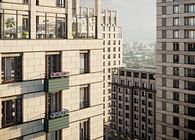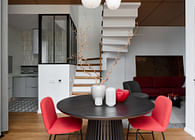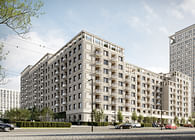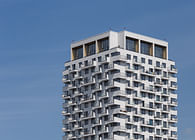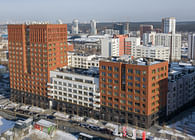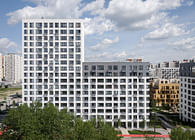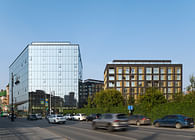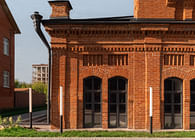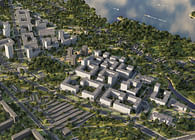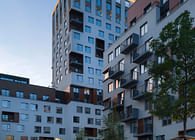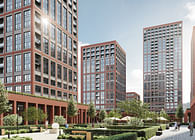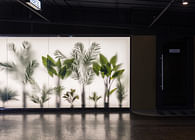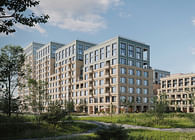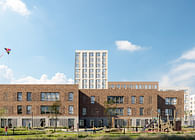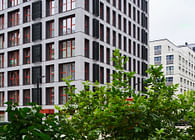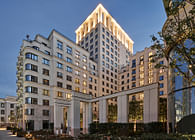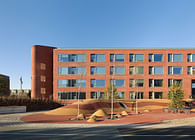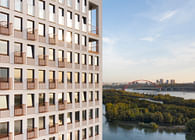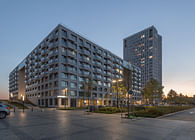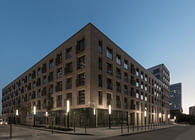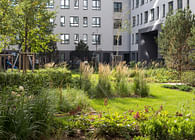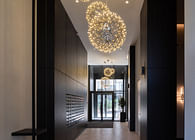
Located in the Uktus Mountains next to the forest park, Shishimskaya Gorka is a residential quarter in the southern part of Yekaterinburg. It is one of the highest locations in Yekaterinburg, offering a view of the city centre and having one of steepest reliefs city-wise. The area was host to factory buildings and workers’ settlements in the 18th and 19th centuries. All the buildings were wooden, and due to frequent fires the district was rebuilt many times. In the Soviet times it saw active construction — first wooden houses were built, later prefabricated ones.
In 2013 KCAP, a Netherlands based bureau, designed a master plan for Shishimskaya Gorka residential quarter, commissioned by Brusnika development company. The key concept of the master plan was to create a system of nature-based public spaces, available to all city dwellers, which would blend the new Mixed Use quarter into the existing environment and landscape.
Shishimskaya Gorka is a large-scale redevelopment project, with a working area of 500 000 square metres. The master plan maps out to fulfil it in three stages comprising the construction of residential premises, towers and urban villas of varying sizes connected by the park. The first stage of construction is in progress with two blocks already completed.
The main feature of the new district is its pedestrian canyon — a large park with 40 meter difference in relief, connecting all constructed objects. The canyon is a cascade of landscaped zones, linked with ramps and staircases, zigzagging upwards to Uktus mountain. Historically, there was a pedestrian route leading to the Uktus mountains and the project team decided to restore it in the new quarter while preserving its hilly relief. The steep mountainous landscape posed a challenge for the architects as they had to design a coherent and functional space while accommodating the needs of different social communities, including those with limited mobility. The following groups were to be considered: mothers with prams, children and teenagers, people in wheelchairs, cyclists and roller skaters, pedestrians and joggers. Another major task was to design a landscape tolerating extreme continental climate that would provide both variety and convenience in all seasons. (The average winter temperature in Yekaterinburg is minus 15 degrees centigrade, however, minus 25 is quite common even at daytime).
The pedestrian canyon features quiet recreational zones for adults equipped with fountains and playgrounds for children over 7 with increased controllable risk. The elevation gradient is no more than 3%. All street furniture is made of metal and larch, while the surfacing is done using grass, sand, decking and pavement slabs arranged in a variety of patterns to zone the canyon.
Before designing all playground zones, Brusnika in collaboration with AFA bureau conducted research on children’s activities, which revealed 8 crucial scenarios: movement, play, experiment, communication, cooperation, relaxation, nature immersion and risk-taking. The above-mentioned activities were all incorporated into the canyon’s play areas. The remaining part of the pedestrian route is natural scenery, making up about 75% of the area.
The canyon planting is done in three tiers: the lower layer consists of shrubs, perennial and melliferous plants; that in the middle comprises well-grown and solitary shrubs; while large-sized, adult trees are placed on the top. Over 30 species have been planted in the area — 15 bushes, 9 perennials and 8 kinds of trees and solitary shrubs. At the foot of the canyon, landscape designers decided to preserve a large spruce, aged 30 to 40 years. This choice is symbolic as it reveals the natural identity of the spot and marks the beginning of its renovation.
The all-year round ornamental landscape can be achieved by choosing the right plants. In autumn it is accomplished by the colour of trees and shrubs’ foliage, in summer — by blooming perennials on display, whereas evergreen trees and colourful shrub stems maintain the decorative effect in winter. Up to nine species of perennials are planted in mixed borders so that they blossom throughout the season all along the pedestrian route. Flowers in continuous bloom and specially designed bird feeders attract both pollinators and birds, encouraging biodiversity in a man-made environment. All the plants have been chosen to tolerate a variety of temperature ranges — from -40 degrees Celsius in winter to +40 degrees in summer.
However, due to global climate change, summer in the Urals is getting longer and hotter every year, and spring is early to come. So as an experiment, the project team planted Canadian hemlocks all along the path, and they have taken root. Mobile greening in summer adds to the beauty of the landscape with potted tropical plant compositions featuring banana trees, bird of paradise plants and canna lilies. They are not typical for the Ural climate, but they thrive here in summer and in colder seasons are taken indoors. 80 linear meters of the canyon out of the planned 360 have been completed so far.
The pedestrian canyon in Shishimskaya Gorka is open to all residents, making it a true local attraction. The area is further developed by opening shopping centres and household amenities all along the route on ground floors of the houses. For two years Brusnika and Cultural Transit art fund have supported Shishimskaya Gorka as an art residence. Artists of varying styles have been staying in a dedicated district area and using the canyon as an exhibition space for installations and events to encourage residents’ involvement.
The pedestrian canyon is a salient example of the way public space can be transformed into a district landmark. A blend of balanced landscape design, retail and cultural activity makes urban environment safer, friendlier and more open, affecting both the new project and the surrounding cityscape.
Statistics
Canyon’s total area ー 14 400 square metres
Canyon’s length — 360 linear metres with 80 linear metres completed
Canyon’s width — 40 metres
Elevation variations — for up to 40 metres
Status: Built
Location: Yekaterinburg, RU
Firm Role: Development, Master plan (with KCAP), Landscaping (with S&P Architektura Krajobrazu)
Additional Credits: Photography by Maxim Loskutov, Ilya Teplov and Sergey Belonosov






